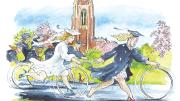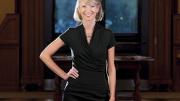1919
With the War Department’s approval, the Faculty of Arts and Sciences votes to resume military training at Harvard, with courses “tuned up to the same [scholastic] standard” as others in the curriculum and military drills to be conducted at summer camps, not on campus.
1929
For Radcliffe’s semicentennial celebration from May 30 to June 1, “the vicinity of Memorial Hall [is] thronged with delegates wearing gaily colored academic costumes”; Mrs. Herbert Hoover brings greetings from the White House; and President Lowell offers the congratulations of Harvard.
1934
The baseball team accepts an invitation to play 12 Japanese college teams over the summer, thereby becoming the first Harvard team and “the first [college] squad from the effete East to carry its bats to the Far East.”
1939
Competing under cover, Edward C.K. Read ’40, president of the Lampoon, wins the annual Wellesley College hoop race, a tradition alleged to determine which member of the graduating class will be married first. According to the Alumni Bulletin, Read reportedly “had accomplices ‘within the ranks’ who fitted him out with the necessary feminine paraphernalia and slipped him into the starting line-up.”
1944
Instructor in chemistry Robert B. Woodward and Polaroid Corporation researcher William von E. Doering ’38, Ph.D. ’43, working together in the University laboratories, have succeeded in synthesizing quinine.
1989
The Graduate School of Arts and Sciences celebrates its centennial on June 2 and 3 with symposia, receptions, and awards to several of its most distinguished alumni.
1999
Harvard joins a yearlong monitoring project, initiated by Notre Dame, to gather information about the conditions inside apparel factories that make university insignia wear and to formulate ideas on how to improve them.









